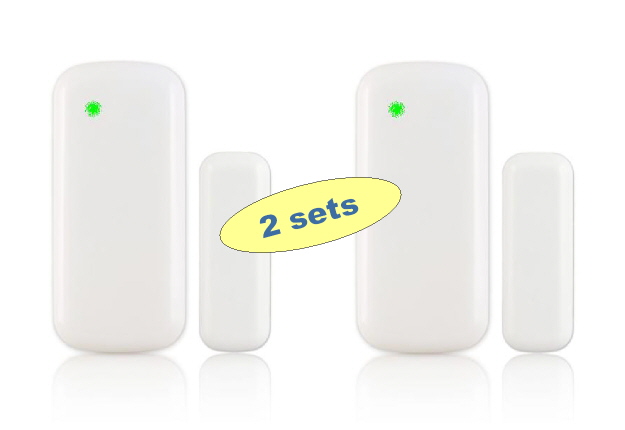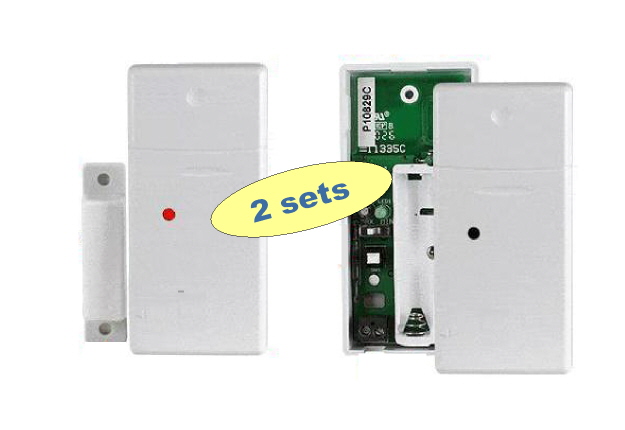Menu
Categories
© Powered by Kenneth Delahoussaye Consulting

Are you a HVAC contractor, supplier, or maintenance/repair company? Click here for discount pricing. No minimum orders, no restrictions, no fine print!
For all others, feel free to contact us for preferred pricing consideration.
Is GEN2 considered obsolete?
(Will it be discontinued?)
We have no plans to discontinue this product generation. GEN2 remains a viable option for the foreseeable future. In fact, it continues to be a popular choice for many of our long-time customers.
Because GEN2 door sensors (X10 classic) use an internal copper-coil antenna, it is less susceptible to signal degradation issues, particularly when used with metal doors and metal-framed openings (e.g., patio doors).
Will it work with my HVAC system?
Generally speaking, we are compatible with most split (central) systems that utilize a traditional 24v thermostat. We may be compatible with other HVAC types as well. Consult the chart below for a compatibility summary:
| System | Description |
||
|
The HSRS is compatible with central/ducted split systems, especially if utilizing a standard, low-voltage (24-vac) control circuit (as most split systems do). |
||
|
PTAC systems range in functionality and options. If your system provides inputs for front desk control and/or door/window monitoring, it should be compatible. Examples include Amana PTC09, Goodman PTH09, and others. |
||
|
A large number of mini-split systems are not conducive to shut-off control by a third party device. However, we may be compatible with some models. Click here for details. | ||
|
Fan-coil systems are typically compatible, especially if they utilize a low voltage (24-vac) control circuit. | ||
|
Variable refrigerant flow (VRF) systems do not utilize a traditional 24v thermostat. Instead, these systems employ a control method that relies on a digital communication protocol. However, some VRF manufacturers may offer a 24v interface (add-on) option that allows the use of a traditional thermostat. In this instance, the HSRS would be easily compatible. Other VRF systems may provide a user-accessible connection input for “external on/off” control. This input usually accepts a simple contact closure via a length of wire, permitting shut-off control by a third-party device such as the HSRS. | ||
|
Most room air conditioners are not conducive to external control by a third-party device. | ||
Will it work with my mini-split unit?
It depends. Many of these systems provide no capability for external controlling the unit with a third-party device (such as the HSRS). However, a few manufacturers provide this capability or otherwise special add-on interface option. (You may wish to contact your HVAC distributor or manufacturer to find out if your particular model supports this function.)
Note: When speaking with your HVAC sales or technical representative, you'll want to ask whether there is an option for shutting off the mini-split unit via external switch and/or relay contacts.
For example, Mitsubishi provides the following add-on items for external control purposes:
In addition, some mini-splits can be shut off by breaking the communications wire between the indoor and outdoor units. These systems would also be HSRS-compatible. (Contact your HVAC sales or technical rep to determine if breaking the comm. wire is a feasible option for shut-off.)
For a complete summary of compatible HVAC types, click here.
Can I connect a wired switch to a wireless door sensor?
Yes. Our GEN2 classic sensor provides internal wiring screw terminals for connecting an optional wired door switch (known as a hybrid sensor configuration). In fact, you may even connect multiple switches in series. Intended primarily for magnetic reed contacts, most any switch type is acceptable as long as it is designed for normally-closed circuits.
A hybrid sensor configuration is ideal for monitoring multiple nearby openings without the need to install additional wireless sensors. It is also well-suited for garage doors, specialty windows, and situations when there may be insufficient mounting space around the opening. For details, click here.
What is your shipping policy?
UPS ground is the default shipping method. Generally speaking, our goal is delivery within 3 business days or less. If necessary, we may upgrade your order to 3-day select or 2nd day air in an effort to reduce transit time.
Is there a remote monitoring option? I want to receive text and/or e-mail alerts.
While the HSRS does not currently provide remote monitoring capability, a cost-effective DIY solution is available. Receive instant alert texts and/or e-mails when HVAC shut-off occurs due to door/window violation. No monthly monitoring fees! Click here for details.
HSRS Wiring Installation
The HSRS is ideally suited for use with split (central / ducted) systems. We recommend installing the HSRS controller near the air handler, and routing a length of low-voltage wire into the HVAC unit for direct access to the 24vac power. (Most types of low voltage wire will suffice such as thermostat, telephone, intercom, or alarm wire.) For wiring details, including sample schematic click here.
Overhead doors & garage doors?
While HSRS door sensors are designed for traditional doors & windows, there is nothing to preclude their use with other openings and door types. However, custom shims may be necessary for proper alignment of the sensor & magnet to ensure they are on the same plane.
When considering a wireless system for use with a metal door, we recommend the X10 door sensor.
For wired applications, you may optionally consider a specialty switch from a third party supplier. A few examples are listed below:
- Seco-Larm SM-226L
- Honeywell 958 Overhead Door Contacts
- Baomain Rotary Lever Sw. #WLCA12-2-Q
Note: Most any wired switch type can be used with the HSRS, as long as it is designed for normally-closed circuits.
Will it work with a smart thermostat?
Our HSRS is fully compatible for use with most conventional thermostats, including smart wi-fi models such as Nest and Ecobee. Keep in mind that when the HSRS shuts off the HVAC system (due to door or window violation), your thermostat may display an error indicating lost power. The error should clear once the HSRS restores normal operation.
What is the transmit range of wireless door sensors?
Signal range can be difficult to assess for a wireless device when applied indoors. This is because wireless signals can be adversely affected by a number of factors including interior walls, large appliances, RF interference, etc. Range specifications provided by the device manufacturer are typically measured under favorable conditions, typically in open air and with no obstructions. But actual usable range will be much lower and can vary from one installation to the next.
Our available wireless sensors are listed and compared below in terms of signal range.
GEN3:
Operating at 345 MHz, these sensors feature an open-air transmit range up to 200 ft (ideal conditions). However, you should presume a usable range of roughly 50 ft.
GEN2:
Our GEN2 classic sensor operates at 310 MHz and features a copper coil antenna, making it less susceptible to signal degradation issues. It has an open air transmit range of 100 ft., with an usable range of approximately 50 to 75 ft.
Comparison Chart:
The chart below compares transmit range for each product generation:
| GEN3 | GEN2 |
|||
 |
 |
|||
| Range |
|
|
||
| Specs | ||||
| |
Will it work with a communicating thermostat?
(not to be confused with a conventional smart thermostat or wi-fi thermostat)
Our HSRS may be compatible with some communicating thermostats. To be clear, a "communicating thermostat" does not refer to a conventional smart thermostat (such as Nest or ecoBee). While conventional thermostats may possess smart features and even provide wi-fi user interfacing, they generally have no high level communications capability with the HVAC system, instead employing traditional low-voltage control wiring (Rc, Rh, C, Y, W, etc.)
Communicating thermostats interact with a control board located within the HVAC system. And unlike a conventional thermostat, it does not directly control the peripheral equipment. Rather, it sends data & command signals to the control board which, in turn, engages the equipment as necessary. Since a communicating thermostat operates through the transfer of data signals, it generally employs fewer wires or may even utilize a wireless interface such as Bluetooth. In some instances, the HVAC control board may provide typical wiring inputs for traditional HVAC control (Rc, Rh, C, Y, W, B, etc). If this is the case, you may the following options for applying our HSRS system:
Notes
Will wireless sensors work with metal doors?
In most cases, wireless messaging is consistent and reliable. Our customers generally encounter no issues with metal-induced interference when using X10 wireless door sensors. The X10 sensor is designed with internal copper coil antenna that delivers a robust RF signal, making it ideally suited for metal doors and metal-framed openings including patio doors.
Less potent sensors may incur noticeably reduced range when applied to a metal surface, mildly in some instances, or severely in others. (Using a wood-oriented sensor on a metal door is not recommended, but may be possible with trial and error testing. Should you decide to go this route, be prepared to make minor positioning adjustments.) If your installation suffers from weak or marginal signal reception, consider two possible options for quickly resolving the matter. Whether considering a new wireless system or having issues with an existing setup, consult our instructional guide for helpful information. Click here for details.
Which wireless system should I choose?
We offer two wireless systems:
While both classes are functionally equivalent, there are some key differences to consider when making your purchase. (Bear in mind that the two classes are not cross-compatible as they operate on different frequencies and protocols. Therefore, you may not use a Class 1 sensor with a Class 2 controller, or vice-versa.) The two classes are discussed below.
For a comparison summary, scroll to the bottom of the page. (Click here for PDF version.)
Class 1:
Manufactured for Honeywell, these sensors are the same type found in compatible security systems. Two (2) Class 1 sensor models are available: mini and basic. Both operate at 345 MHz, and are advertised with a transmission range up to 200 ft. (open air). However, we have found the usable range is typically lower and can vary widely from one installation to the next. Therefore, you should presume a max range of 50 ft. Class 1 sensors store a factory-assigned ID (address) and need only be registered (i.e., paired) once at the controller/receiver. Long-life lithium battery is included, lasting 5 years or more.
Class 2:
Tried and true, our X10 sensor has withstood the test of time. Operating at 310 MHz and featuring internal copper-coil antenna, this device packs a wallop. Less susceptible to signal degradation issues, it yields excellent open air transmit range and higher usable range than Class 1 sensors (50 to 75 ft. typical). Due to a robust RF signal output, it is the best option for metal doors and metal-framed openings including patio doors. The sensor stores a random, self-assigned ID (address). Therefore, re-registration at the controller is required whenever batteries are replaced. Two (2) AAA alkaline batteries are required (not included), delivering up to 2 years of reliable operation. (Use optional lithium cells for even longer battery life!)
Comparison Chart:
The chart below compares critical features of the two wireless sensor classes:
What is the current-switching capacity?
The Kadtronix family of smart relay systems are rated as follows:
Any tips for completing a proper install?
Installation is straightforward and requires no special skills other than your existing expertise with HVAC systems and basic wiring. Consider the following tips for a smooth, trouble-free installation:
Tip #1: When installing the HSRS wireless system, be careful to avoid contacting the antenna to any grounded surface such as the HVAC equipment chassis. For best RF reception, locate the antenna as high as possible (i.e., just below the ceiling). Also, ensure a minimum separation of 3 feet from any of the following:
Tip #2: If GEN3 wireless sensors are to be applied to metal doors, windows, patio doors, or other metal framed opening, you'll want to be prepared to make adjustments to combat possible metal-induced interference. (Applies primarily to GEN3 sensors. GEN2 door sensors are better equipped to overcome interference issues.)
If installing a GEN3 wireless sensor to a metal surface, apply masking tape to temporarily mount the sensor until confirming proper & consistent signalling with the controller/receiver. Consult the following resource for details:
Tip #3: When installing a wireless door/window sensor, consider the following:
Tip #4: Before permanently mounting wireless door/window sensors, first complete the registration (i.e., pairing) procedure, keeping the sensors close at hand for convenience. Following registration, test to ensure the controller unit recognizes door sensor activity. Once you are satisfied the system is behaving properly, apply the sensors as desired.
Is it safe for my A/C compressor?
Absolutely. First, consider that modern HVAC systems are equipped with built-in delay mechanisms to ensure that refrigerant pressures have equalized before allowing the compressor to start. Second, our HSRS controller features its own configurable delays, described below:
Delay #1 minimizes the possibility of short-cycling by preventing shut-off unless the monitored door or window remains open for a preset time period. Configurable from 0 to 600 minutes (10 hours), the typical setting for most installations is 2 minutes. Therefore, a door must remain open continuously for 2 minutes before shut-off is invoked.
Delay #2 is a configurable re-activation timer that prevents the HVAC system from restarting until the desired time elapse. As mentioned earlier, most HVAC systems provide their own built-in delay for this purpose, so a secondary delay is typically not required. Still, we find that some customers prefer to deploy it for added peace of mind.